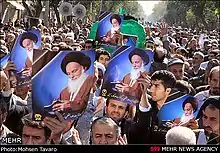Karamatollah Malek-Hosseini
Seyed Ayatollah Karamatollah Malek-Hosseini (1924 – 2 November 2012) (Persian: سید کرامتالله ملکحسینی) was an Iranian Ayatollah and member of the Second, Third and Fourth terms of the Assembly of Experts.[1][2]
Karamatollah Malek-Hosseini | |
|---|---|
| Member of Second, Third, and Fourth terms of the Assembly of Experts | |
| In office 8 October 1990 – 2 November 2012 | |
| Preceded by | Ghorban Ali Shahmiri |
| Succeeded by | Seyed Sharaf-Aldin Malek-Hosseini |
| Constituency | Kohgiluyeh and Boyer-Ahmad Province |
سید کرامتالله ملکحسینی | |
| Title | Ayatollah |
| Personal | |
| Born | 1924 |
| Died | 2 November 2012 (aged 87–88) |
| Religion | Islam |
| Nationality | Iranian |
| Children | Seyed Sharaf-Aldin Malek-Hosseini |
| Parent |
|
| Jurisprudence | Twelver Shia Islam |
| Alma mater | Qom Hawza |
| Teachers | Ruhollah Khomeini, Hossein Borujerdi, Muhammad Husayn Tabatabai, Seyed Mohammmad Taqi Khonsari, Seyyed Mohammad Hojjat Kooh Kamari, Seyed Mohammad Mohaqeq Damad |
| Muslim leader | |
Students
| |
Biography
Karamatollah Malek Hosseini was born in a village called Gusheh-ye Shahzadeh Qasem in Kohgiluyeh and Boyer-Ahmad Province to a religious family in 1924.[3] His father Seyed Sadr-Aldin Malek-Hosseini was a prominent cleric in Boyer-Ahmad.[4] He studied Islam in both Shiraz and Qom. During the Iranian Revolution he was a critic of the Pahlavi regime and was arrested by SAVAK. After the revolution he served in the Assembly of Experts, as well as representing the Supreme Leader of Iran in Kohgiluyeh and Boyer-Ahmad Province.[5] After his death, his son Sharaf-Aldin took his spot for the remainder of the fourth term and then was elected again for the Fifth term.[6]
Religious education
From an early age he was learning Islam and Arabic from his father. When he was 15, he migrated to Shiraz to continue his education in high school. Afterwards, in 1941 he officially began his Islamic Studies. There, he learnt under Abdul-Karim Haeri Yazdi and Mirza Ahamd Darabi.[7] After, he finally migrated to Qom to further his Islamic studies in Qom Seminary. There, he was taught by the likes of Hossein Borujerdi, Ruhollah Khomeini, Muhammad Husayn Tabatabai, Seyyed Mohammad Hojjat Kooh Kamari, Seyed Mohammad Taqi Khonsari, and Mohammad Mohaqeq Damad. There he mastered his knowledge in Islamic jurisprudence, interpretation of Quran, and Usool Fiqh. It was in Qom where he reached the level of Ijtihad. After the passing of Hossein Borujerdi in 1961, he migrated back to Shiraz to begin teaching at the Khan Theological School.[8]
Political activism
While teaching in Shiraz, Karamatollah began to resent Mohammad Reza Pahlavi and the Pahlavi regime. This happened primarily after the attack on Feyziyeh Seminary on March 22, 1963. SAVAK agents and operatives disguised as farmers stormed the seminary, beating many clerics and killing young Seyed Younes Rudbari as he was beaten to death.[9] Another 2-3 students were killed due to injuries sustained from being beaten and thrown off rooftops.[10] Afterwards, Karamatollah would often give Khutbahs in the Habib Mosque in Shiraz showing his resentment to the Pahlavi regime. His infamous arrest by SAVAK was in 1978 where a crowd that gathered at Habib Mosque clashed with SAVAK. Three protestors were killed as a result of gunfire, which then led to the arrest of Seyed Karamatollah.[11] His arrest led to protests by tribesman across the Kohgiluyeh and Boyer-Ahmad province, and Shiraz. As a result of these protests he was released 2 days later.[12]
Students
- Seyed Ali Asghar Hosseini
- Seyed Sharaf-Aldin Malek-Hosseini
- Seyed Ali Mohammad Bozorgvari[13]
- Mohammad Reza Adinehvand
- Sheikh Ghader Haydari Fasai
- Sheikh Mostafa Zamani
- Sheikh Abotaleb Abadi Genavehi
- Sheikh Yousef Salmanzadeh Borazjani
- Sheikh Khodamrad Raji Abarqawi
Death
Seyed Karamatollah passed away on the morning of 2 November 2012 in Namazi Hospital, Shiraz.[14] His death prompted Ali Khamenei expressing his condolences.[15] Many had attended his funeral as he was a very popular figure in Kohgiluyeh and Boyer-Ahmad, he was buried in his hometown Gusheh-ye Shahzadeh Qasem.


See also
References
- "1998 Assembly of Experts Election - Iran Data Portal - 1998 Assembly of Experts Election". 2015-10-19. Archived from the original on 19 October 2015. Retrieved 2022-01-23.
- "2006 Assembly of Experts Election - Iran Data Portal - 2006 Assembly of Experts Election". 2015-09-24. Archived from the original on 24 September 2015. Retrieved 2022-01-23.
- "دربارۀ آیت الله سید کرامت الله ملک حسینی". www.imam-sadr.com. Retrieved 2022-01-24.
- "زندگینامه: سید کرامتالله ملک حسینی (۱۳۰۳ - ۱۳۹۱)". همشهری آنلاین (in Persian). 2012-11-03. Retrieved 2022-01-24.
- YJC, خبرگزاری باشگاه خبرنگاران | آخرین اخبار ایران و جهان |. "مرحوم سید کرامت الله ملک حسینی از مفاخر ملی است". fa (in Persian). Retrieved 2022-01-24.
- ها, اخبار استان. "فهرست نمایندگان دوره پنجم مجلس خبرگان رهبری". fa (in Persian). Retrieved 2022-01-24.
- قرآن, iqna ir | خبرگزاری بین المللی. "نگاهی به زندگینامه مرحوم آیتالله سید کرامتالله ملک حسینی، از مشاهیر کهگیلویه و بویراحمد". fa (in Persian). Retrieved 2022-01-24.
- "نگاهی به شخصیت فقید آیت الله سید کرامت الله ملک حسینی - ایرنا". khabarban.com. Retrieved 2022-01-24.
- "سید یونس رودباری، اولین شهید نهضت امام خمینی(ره)". ایرنا (in Persian). 2015-01-31. Retrieved 2022-01-24.
- "حمله به مدرسه فیضیه-مؤسسه مطالعات و پژوهشهای سیاسی". psri.ir. Retrieved 2022-01-24.
- اسلامی, مرکز اسناد انقلاب. "اعتراض عشایر یاسوجی نسبت به دستگیری آیتالله سید کرامتالله ملکحسینی در سال 57 +سند". fa (in Persian). Retrieved 2022-01-24.
- "ماجرای مبارزه آیتالله سید کرامتالله ملک حسینی با طاغوت در شیراز". اول فارس | آخرین اخبار ایران ،جهان و فارس (in Persian). 2019-11-04. Retrieved 2022-01-24.
- Maijidi Karaei, Noor Mohammad (1999). Scholars and Poets of Kohgiluyeh and Boyer-Ahmad Provinces (in Persian). Iran: Beharfarin. p. 65.
- "ملک حسینی، سید کرامت الله". hawzah.net. Retrieved 2022-01-24.
- "پیام تسلیت رهبر معظم انقلاب در پی درگذشت آیتالله ملک حسینی". www.leader.ir (in Persian). Retrieved 2022-01-24.